By: Grace Shymanski, Bicentennial Intern, Class of 2017, French and History, Bloomington
The inventor of basketball Dr. James Naismith once said: “Basketball really had its origin in Indiana, which remains the center of the sport”. Hoosiers have loved basketball since it was brought to the state by Nicholas McKay in 1892, a year after its creation by Dr. Naismith in Springfield, Massachusetts. It was the native Hoosier McKay who began using iron hoops and coffee bags instead of Naismith’s peach-baskets[1]. Basketball has reached mythologized status in Indiana culture[2].
However, the story of the women’s basketball remains undeveloped in our state narrative. From the beginning, women in Indiana have admired, played, and participated in the growth of the game and its culture. In an attempt to make the invisible visible, the development of women’s basketball as well as the larger framework of women’s athletics serves as an example of the contributions and continued resolve held by Hoosier women to participate and integrate themselves into the male dominated field of athletics.
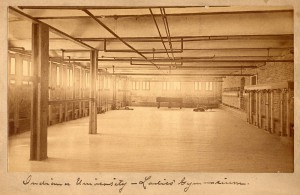
At the onset, women participated in the game of basketball. During the 19th century, the ideal woman had been characterized as “a small waisted, small footed, small brained damsel, who prided herself on her delicate health, who thought fainting interesting, and hysterics fascinating”[3]. However, the collegiate woman began to realize the development of her body in a scientific and thorough method resulted in the highest development of true womanhood[4].
“Basket Ball, the game that has helped to develop the athletic spirit in women more than any other, that has given us the best results, and aroused the greatest enthusiasm.”—Senda Berenson
Women’s gymnasium began to be seen as an essential aspect of the coed’s collegiate experience. By 1890, Indiana University’s administration made the necessary efforts to provide the required facilities and equipment for the promotion of the Department of Physical Training for Women[5]. Basketball was integrated into the curriculum almost immediately. The Hoosier women of the 19th century actively participated in the promotion and admiration of the sport of basketball in Indiana culture.
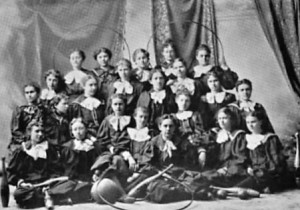
During this time, women used “the south half of the basement of Wylie Hall” as their gymnasium[6]. Wylie Hall housed the first interclass basketball competitions. Despite the fumes from the chemistry labs above, the support pillars in the court, and the low ceilings Hoosier women continued to play basketball. The development of the gymnasium program and the continued force to better the location came from Miss Juliette Maxwell.
The development of women’s athletics and the department as well as higher education standards largely occurred due to the continued and persistent work of Miss Juliette Maxwell without her many contributions women’s athletics would not have succeeded to gain ground. In part because of Miss Maxwell, the Women’s Gymnasium found a better home in Mitchell Hall for a decade before moving to the Student Building[7].
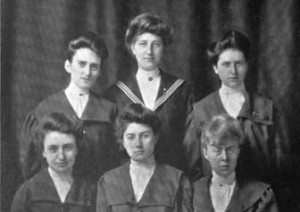
Edna Munro[8] attributes the growing spirit of emancipation among women as a primary reason for the growth of desire “for more meaningful recreation and functional activity experiences”[9]. By 1902, the Arbutus reported athletic interest had spread to the young women of Indiana and as a result of their enthusiasm for the sport of basketball, a girls’ championship had been arranged.
Hoosier women developed interclass competitions which competed in tournaments every year with an honorary varsity team being nominated at the end of the season. Due to a large amount of interests for athletics, a formal athletic association was created to organize and promote women’s athletic activities on campus.
This organization came to be known as the Women’s Athletic Association or W.A.A. Its membership was limited to undergraduates who had obtained 100 points within their system. However, the story of growth and expansion of women’s participation does not illustrate the full story of the sport at this time. The public continued to view athletics as a form of masculinization of women and continued to hold the belief women should only participate in feminine sports.
By the end of the 1920s, the national acceptance of women as athletes had taken a different direction. Led by First Lady Mrs. Herbert Hoover, the new aim for athletics among girls was a no girl left behind approach. She found inter-scholastic competition to overexcite the crowd in its desire to have a victor, limit play opportunities to a select few, overstrain the “star” athlete, diminish the quality of the sport as it was lost in the nervousness of the game, and lastly, sportsmanship was often lost in “hair pulling” episodes[10].
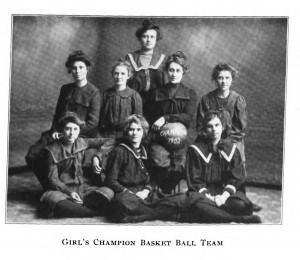
Her condemnation of the more competitive nature of women’s athletics led to an increase in Play Days. Hutchison reports on the Bloomington campus: “Competition during this period was limited to Play Day type of get together for friendly fellowship[11]”. The national sentiment and philosophical decline in competitive characteristics of female athletes should not be confused with the thriving basketball culture amongst the Hoosier coeds.

Basketball remained in first place in the hearts of coed athletes at Indiana[12]. The interclass competitions occurring at Indiana University had resulted in a surplus of girls being rejected from the class teams which held fierce competition a seen in 1922 when one hundred extra women had reported for practices for the freshman squad.
“The ideals of the Women’s Athletic Association are: Physical efficiency, scholarship, and good fellowship among the women of the University.”—Arbutus 1918
Therefore, two parallel tracks emerged. Hoosier coeds participated in Play Days as the Department followed national trends, but they refused to stop their fierce competition and love of basketball. By 1928, the Arbutus reported “the athletic coed has entered into her own kingdom. No longer need she camouflage behind romance language and home economics.[13]”
“As is the case everywhere in Indiana with both men and women, basketball was very popular. Practically every organization had a team entered…”—Arbutus 1922
In a statewide context, the development of Play Days at Indiana University resulted in the increase in high school women’s participation in basketball. The university not only hosted Plays Days for undergraduates but also for high school women from across the state to have opportunities to participate in athletics.
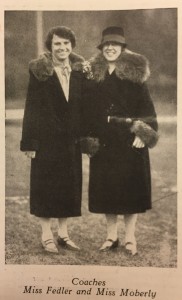
With the Girls’ Athletic Association, Indiana University initiated the first of these high school competitions in Bloomington in 1929[14]. While the encouragement of competitive athletics diminished, the overall participation of women’s athletics continued to be supported by the University and inspired a new wave of women to continue to develop a space for themselves in the field of athletics.
“These programs provided the opportunity for women to experience competition in a wholesome healthy atmosphere, devoid of bias and strong emotion.”—Edna Munro
For part two of this blog, please visit: https://blogs.iu.edu/bicentennialblogs/2016/12/13/a-history-of-early-womens-basketball-at-iu-part-2/
Bibliography
Berenson, Senda. “Basket Ball for Women.” Physical Education III, no. 7 (1894): 106-109.
Gregg, Elizabeth Anne. A History of Women’s Intercollegiate Athletics At Indiana University- Bloomington: 1965–2001 : a Historical Case Study. [Bloomington, Ind.]: Indiana University, 2007. Hutchison, Isabella. (1995) History of Women’s Athletics (unpublished). Indiana University, Bloomington.
Indiana University, Arbutus 1922 Yearbook, (Bloomington, IN), Indiana University Archives, Archives Reading Room.
Munro, Edna F. History of the Department of Physical Education for Women At Indiana University. Bloomington, Ind.: Indiana University, 1971.
West, Eva. “How We Killed Basketball.” Indianapolis Monthly, March, 2007.
Works Cited
[1] Evan West, “How We Killed Basketball,” Indianapolis Monthly, March 2007, 129.
[2] Evan West, “How We Killed Basketball,” Indianapolis Monthly, March 2007, 129.
[3] Senda Berenson, “Basket Ball for Women,” Physical Education III, no. 7 (1894): 106.
[4] Senda Berenson, “Basket Ball for Women,” Physical Education III, no. 7 (1894): 106.
[5] Isabelle Hutchison. History of Women’s Athletics (unpublished). Indiana University, Bloomington. 1995.
[6] Indiana University, Arbutus 1920 Yearbook, (Bloomington, IN), Indiana University Archives, Archives Reading Room.
[7] The Student Building was constructed to serve as the woman’s building on campus. Mrs. Francis Swain was instrumental in its fundraising and construction. The Student Building was renamed in her honor in 2016.
[8] Edna Munro served as a faculty member in the Department of Physical Education for Women from 1928 to 1961.
[9] Edna Munro. History of the Department of Physical Education for Women At Indiana University. Bloomington, Ind.: Indiana University, 1971.
[10] Mrs. Herbert Hoover
[11] Isabelle Hutchison. History of Women’s Athletics (unpublished). Indiana University, Bloomington. 1995.
[12] Indiana University, Arbutus 1922 Yearbook, (Bloomington, IN), Indiana University Archives, Archives Reading Room.
[13] Indiana University, Arbutus 1928 Yearbook, (Bloomington, IN), Indiana University Archives, Archives Reading Room.
[14] Edna Munro. History of the Department of Physical Education for Women At Indiana University. Bloomington, Ind.: Indiana University, 1971.
Fascinating and important.Bravo to IU and its student researchers for bringing the past into the present acknowledging and celebrating the efforts, hurdles and triumphants of pioneering women athletes:fortitude, passion, strong minds, wills and bodies!
Well done historical portrait of the role of women in sport and athletics.